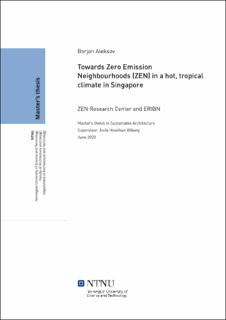| dc.description.abstract | This paper analyzes the potential of implementing Zero Emission Neighbourhood (ZEN) strategies for reduced environmental impact in warm climates, thorough the campus of Nanyang Technological University in Singapore.
The ZEN Center in Norway has started investigating an idea of distributing energy resources between interconnected buildings by creating synergies that balance out individual demands and achieve
collective zero emissions. Valuable conclusions have already been drawn from several pilot projects in Norway, which motivates for further research in different climatic contexts. In parallel, an anticipated growth
in conditioned floor area in South and Southeast Asia raises awareness of the increased energy consumption for cooling. The upsurge will consequently lead to higher Greenhouse Gas (GHG) emissions, which
motivates the development of this paper aiming to induce a rapid decline and compensation for emissions from cooling.
The project analyzed six selected buildings on NTU’s campus by evaluating them against a set of parameters including passive design strategies, existing campus ambitions for achieving zero energy,
conditioned floor area and PV electricity generation. Additionally, each building’s profile was quantified with GHG emissions from cooling. The calculation was obtained by multiplying energy consumption data of the
chiller plants that maintain conditioned areas in the buildings and the grid emission factor for Singapore.
The results indicate that emission reduction can be achieved in the individual building profiles, but an emphasis is put on creating ZEN synergies that will neutralize GHG emissions for the connected
buildings. An approximate calculation of the potential PV electricity generation by a building that is 98 per cent naturally ventilated demonstrated that it can generate a surplus of energy sufficient for satisfying cooling demands of a building that is 100 per cent mechanically cooled. An even larger synergy can be beneficial for
efficient management of peak loads in energy generation and could help to avoid constraints from inefficient energy storage with current technology. Moreover, synergies can transcend the physical connection and could be achieved with digital aid and transportation systems.
This paper potentiates the applicability of synergetic ZEN connections in warm climates and paves the road for future more detailed research in similar contexts. The concluding recommendations can be directly tested in a pilot project at NTU’s campus. | |
